 All Our Tours
All Our Tours
Written by: Alice Le
Updated date:09/10/2025
Hello, I’m Alice. I’m a passionate travel expert with years of experience exploring Vietnam, Laos, Cambodia, and Thailand. My journeys through these countries have given me a deep appreciation of their landscapes, traditions, and cultures, which I now share through authentic insights and tailored recommendations. With this expertise, I can design trips that perfectly match your expectations and create truly unforgettable journeys. I’m here to guide you toward unique experiences, crafted just for you.
Contents
If there’s one celebration that captures the heart and soul of the country, it’s Tet Holiday in Vietnam- the Vietnamese Lunar New Year. More than a public holiday, Tet is a time when the entire nation pauses, families reunite, and every home prepares for a new beginning filled with hope, joy, and prosperity.
Whether you’re planning to travel to Vietnam in February 2026 or simply want to understand this deeply meaningful celebration, this guide will help you uncover the true spirit of Tet – what it means, when it happens, and how to experience it like a local.
Tet Nguyen Dan (Tết Nguyên Đán) literally means “the Feast of the First Morning of the First Day.” It’s the most important festival in Vietnam, marking the start of the lunar calendar year – similar to Chinese New Year but with distinct Vietnamese customs and traditions.
Tet usually falls between late January and mid-February, depending on the lunar cycle. It celebrates renewal, rebirth, and family unity. During Tet, Vietnamese people:
As Tet follows the lunar calendar, its date changes each year, usually coinciding with the Chinese Lunar New Year. While the official Tet holiday in Vietnam lasts around 5–7 days, the entire celebration including the preparations beforehand and the post-holiday customs so it often stretches over 10 to 14 days. In fact that the festive atmosphere begins weeks in advance and continues for several days after the official break.
When Is Tet Holiday 2026?
In 2026, Tet will officially start on Tuesday, February 17, 2026, marking the Year of the Horse (Giáp Ngọ) according to the Vietnamese zodiac.
However, preparations begin well before the date. Here’s the general breakdown:
– Pre-Tet period (February 10–16, 2026): Markets and streets are alive with festive shopping, flower stalls, and people traveling home.
– Main holiday (February 16–20, 2026): Most government offices, banks, and many restaurants will close for about 5–7 days.
– Post-Tet (February 21–24, 2026): Families visit friends, burn offerings (hóa vàng), and gradually return to work.
Tip for travelers: Arrive a few days before the main holiday to witness the vibrant pre-Tet atmosphere -flower markets, red decorations, and cultural excitement everywhere.
Tet Nguyen Dan, or the Vietnamese Lunar New Year, is far more than a simple celebration, it is the emotional and spiritual heartbeat of Vietnam. For centuries, Tet has reflected the nation’s most cherished values: family unity, gratitude, respect for ancestors, and hope for the future. No other holiday carries such profound meaning or touches every Vietnamese life in such a personal way.
Tet represents the Vietnamese way of life – a deep respect for the past, optimism for the future, and joy in the present. It’s a time when cities slow down, hearts open, and every family – no matter where they are in the world – feels the pull of home. That’s why Tet isn’t just the start of a new year; it’s the renewal of the Vietnamese spirit itself.

Why Tet Is the Heart of Vietnamese Culture?
Traveling to Vietnam during Tet Holiday is one of the most magical and memorable experiences you can have. The entire country transforms into a vibrant sea of colors, traditions, and emotions. It’s a time when modern life slows down, and family, culture, and heritage take center stage.
As the Vietnamese Lunar New Year approaches, the festive atmosphere builds weeks in advance. Streets are decorated with red and gold banners, symbolizing luck and prosperity, and adorned with flower stalls, colorful lanterns, and kumquat trees, which represent wealth and happiness. The air is filled with the sweet scent of peach blossoms in the North and yellow apricot flowers in the South, two iconic Tet symbols.
During Tet, every corner of Vietnam feels alive. In big cities like Hanoi, Ho Chi Minh City, Da Nang, and Hue, locals dress up in elegant áo dài and visit family, friends, and temples to pray for good fortune in the year ahead. You’ll hear greetings of “Chúc Mừng Năm Mới!” echoing everywhere – meaning Happy New Year!
When night falls, the festive mood reaches its peak. Fireworks light up the skies in major cities such as Hanoi’s Hoan Kiem Lake, Ho Chi Minh City’s Saigon River, and Da Nang’s Dragon Bridge. Streets come alive with lion dances, traditional drumming, and live music. Everything makes you have a joyful and energetic scene that brings locals and visitors together.
Beyond the public celebrations, Tet is about family and connection. Shops and restaurants may close for a few days as people return to their hometowns, share meals, and honor their ancestors. But this also creates a rare opportunity for travelers: a chance to witness Vietnamese warmth and hospitality up close. Don’t be surprised if you’re invited to join a family meal or share a cup of tea with locals, it’s part of the Tet spirit. These spontaneous encounters make your journey more meaningful, offering an authentic glimpse into how Vietnamese people cherish family bonds and celebrate togetherness.
Travel Tip:
If you plan to visit during Tet, be sure that you book a tour in advance, transport and accommodation early, as it’s the busiest travel period of the year. Be prepared for some closures, but embrace the slower rhythm, it’s your chance to experience Vietnam at its most genuine and joyful.
Let Asia Viva Travel help you craft the perfect itinerary and discover the heart of Vietnam in comfort, style, and unforgettable depth.

What to Expect During the Tet Holiday in Vietnam?
As the old year fades, Vietnamese families clean and decorate their homes, not just for beauty but to sweep away bad luck and welcome new beginnings. Every house glows with red and gold decorations, colors symbolizing happiness, success, and prosperity. Peach blossoms, apricot flowers, and kumquat trees fill homes with fragrance and life, each carrying a message of renewal, growth, and balance between heaven and earth.
At the heart of Tet lies ancestor worship, a practice deeply rooted in Vietnamese spirituality. Families prepare special altars with fruits, flowers, and food offerings to invite their ancestors to join the celebrations. It’s a way of showing gratitude to those who came before and ensuring their blessings for the year ahead. This tradition connects generations and reminds everyone of their shared heritage and identity.
Besides, food plays a sacred role during Tet. The most iconic dishes are Bánh Chưng in the north and Bánh Tét in the south, which represent the earth and the sky, wrapped in green banana leaves and filled with rice, mung beans, and pork. Cooking these cakes is often a family affair, lasting through the night as relatives gather around the fire, sharing stories and laughter. It’s a symbol of family bonding, generosity, and continuity.
As the clock strikes midnight on New Year’s Eve, the atmosphere across Vietnam becomes electric. People light incense and pray for good fortune, fireworks illuminate the sky, and offerings are made to both ancestors and the Kitchen Gods (Ông Táo), who are believed to return from heaven to report on the household’s deeds from the past year. Major cities like Hanoi, Ho Chi Minh City, Da Nang, and Hue host spectacular fireworks displays, while local temples fill with people making their first prayers of the year.

Bánh Chưng in the north and Bánh Tét in the south
The First Days of Tet
During Tet, every action and word carries meaning. People wear new clothes to symbolize a fresh start, exchange warm greetings of “Chúc Mừng Năm Mới” (Happy New Year), and give children red envelopes filled with lucky money (lì xì) to wish them success and happiness. Even daily behavior follows cultural beliefs to avoid arguments, harsh words, or breaking objects, as these could bring bad luck.

How Vietnamese Celebrate Tet?
If you want to truly feel the warmth, joy, and tradition of the Vietnamese New Year, visiting Vietnam during Tet (Tết Nguyên Đán) is an unforgettable experience. Each region of the country offers its own flavor of celebration from ancient rituals in the North to colorful festivals in the South. Here are the best destinations in Vietnam to experience the magic of Tet:
As the capital city, Hanoi perfectly captures the essence of Tet, balancing modern energy with deep-rooted traditions. In the days before the holiday, Hang Ma Street in the Old Quarter bursts into color with stalls selling red envelopes, lucky charms, calligraphy, and festive decorations. The atmosphere is electric, locals rushing to prepare, families shopping together, and the scent of incense filling the air.
Don’t miss Quang Ba Flower Market, where thousands of fresh flowers, peach blossoms, and kumquat trees arrive daily from nearby villages. It’s busiest before dawn, offering photographers and travelers a glimpse into local Tet preparations. You can see a lot of kumquat trees, peaches and flowers along the streets, making a picturesque view.
On New Year’s Eve, tourists can join locals as they pray for blessings at Tran Quoc Pagoda or Ngoc Son Temple and watch fireworks illuminate Hoan Kiem Lake. The mix of traditional rituals, joyful crowds, and vibrant streets makes Hanoi one of the most iconic places to celebrate Tet.
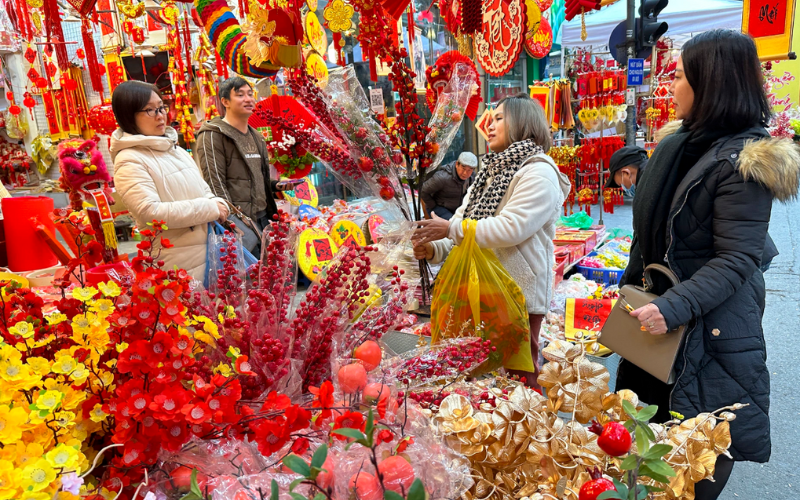
Explore Hanoi – A Blend of Tradition and Celebration
Few places in Vietnam feel as enchanting as Hoi An during Tet. This UNESCO World Heritage town already glows nightly with its famous lanterns, but during the Hoi An Lantern Festival, which often coincides with Tet, the atmosphere becomes truly magical. Thousands of colorful lanterns float along the Thu Bon River, creating a fairy-tale setting that symbolizes hope and renewal.
Visitors can join locals in traditional games, watch folk performances, and take part in river offerings to wish for prosperity. The town’s ancient streets, lined with yellow colonial buildings and temples, become a backdrop for family reunions and spiritual ceremonies. For travelers seeking a blend of culture and charm, Hoi An is a dream destination during Tet.
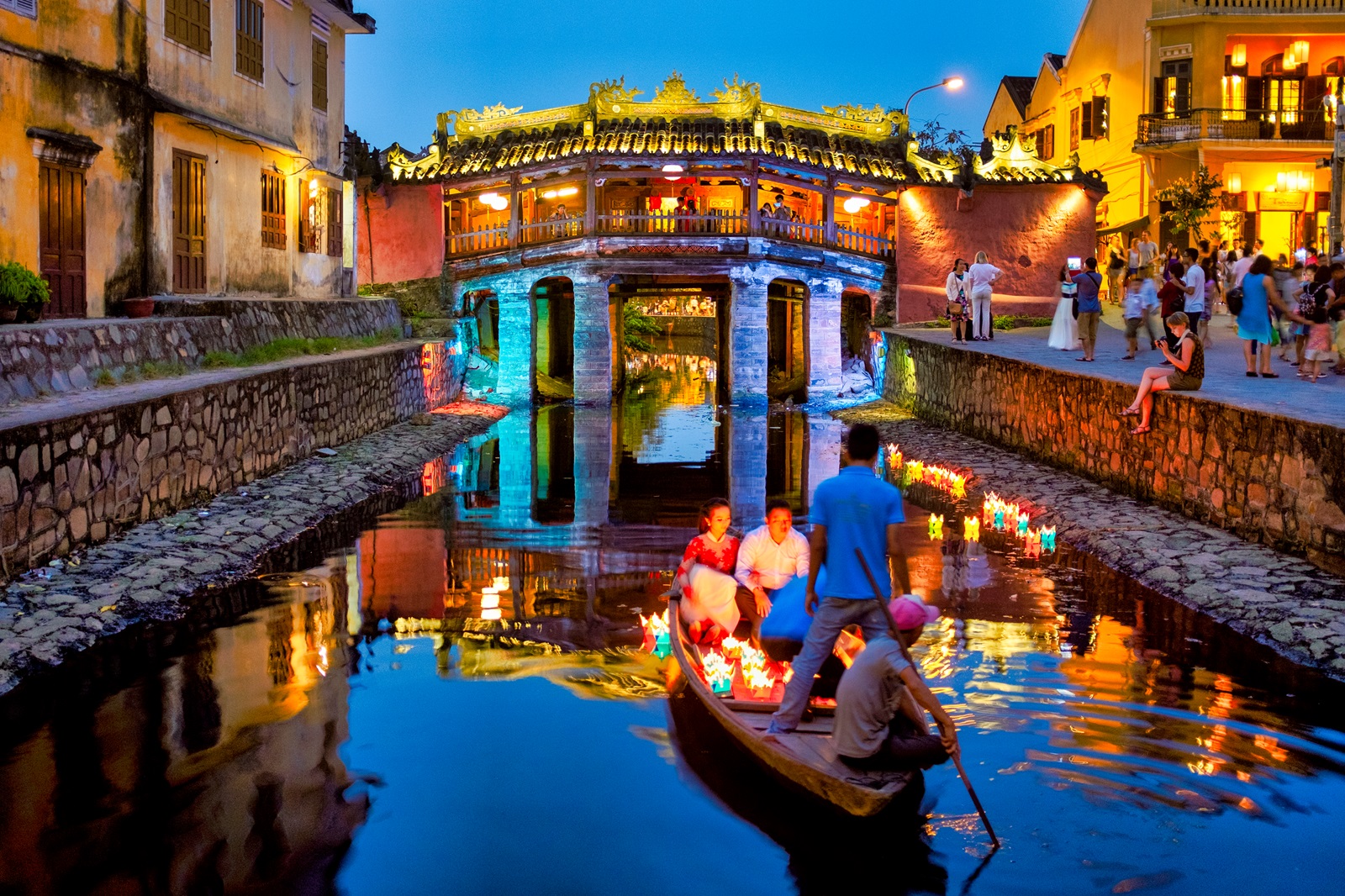
Visit Hoi An – Lanterns and New Year Magic
The Tet atmosphere in this bustling city is undoubtedly unique and captivating, leaving an unforgettable impression. You can enjoy the stunning fireworks display at Han River Bridge, pray at Linh Ung Pagoda – offering prayers for peace and prosperity at the start of the year. It’s also a great time for you to check-in at the Tet flower street, filled with vibrant spring colors in Danang.
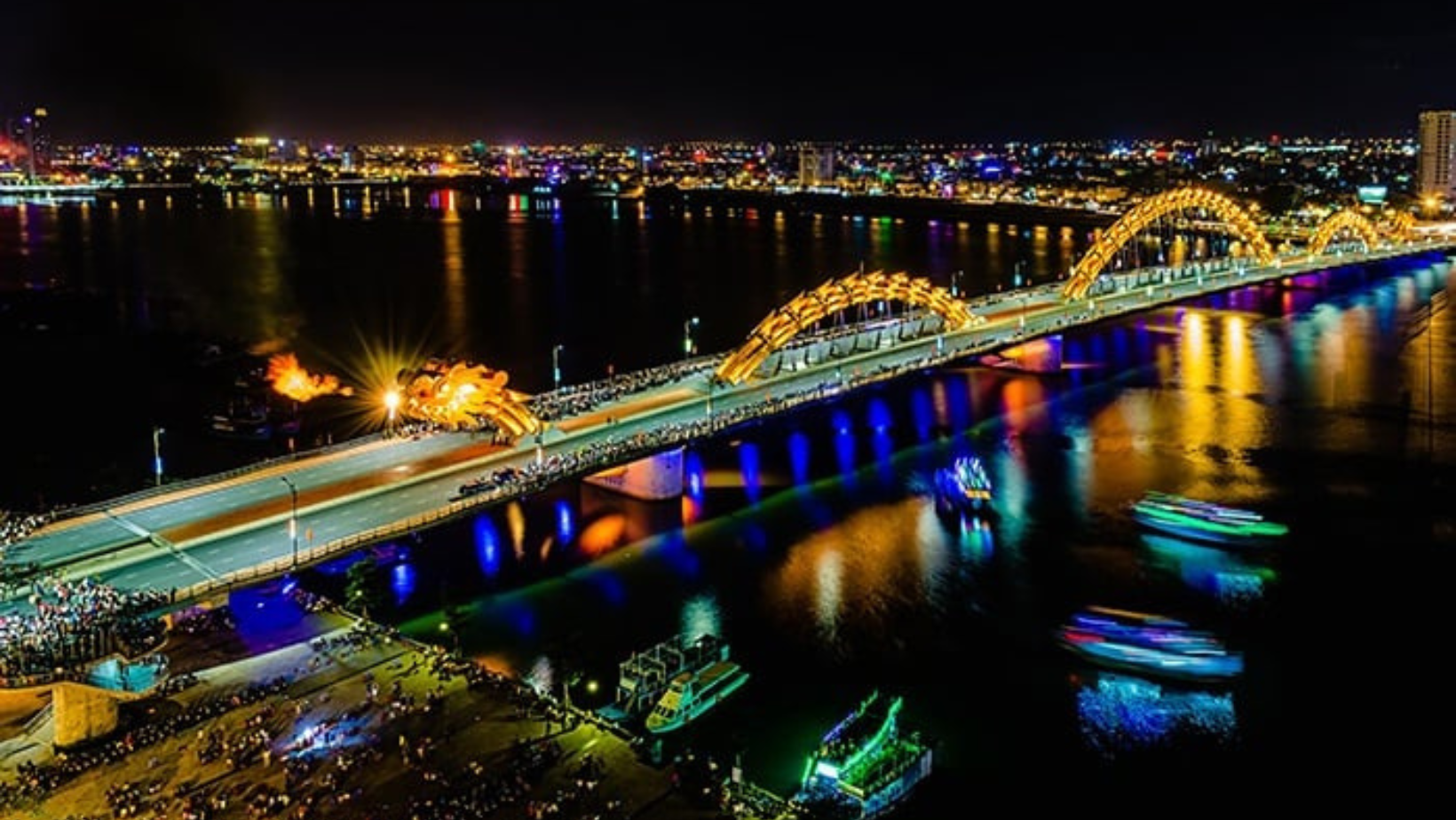
Enjoy experiencing Tet celebration vibes in Da Nang
Southern Vietnam’s largest metropolis, Ho Chi Minh City, celebrates Tet with unmatched energy and excitement. Nguyen Hue Flower Street in District 1 is transformed into a stunning floral walkway, featuring thousands of elaborate flower displays, bonsai trees, and traditional art installations. It’s one of the most photographed spots during the holiday.
For a deeper cultural experience, head to Ben Thanh market, Cholon (District 5), the city’s Chinatown, where Chinese-Vietnamese communities hold colorful New Year festivities. Temples like Thien Hau Pagoda are filled with offerings, incense, and prayer, creating a rich spiritual atmosphere.
On New Year’s Eve, tourists don’t miss to watch fireworks at Landmark 81, Thu Thiem Bridge, or Saigon River, where locals gather to celebrate under the sparkling skyline. Ho Chi Minh City is the best choice for travelers who want a lively, modern Tet experience with a touch of tradition.
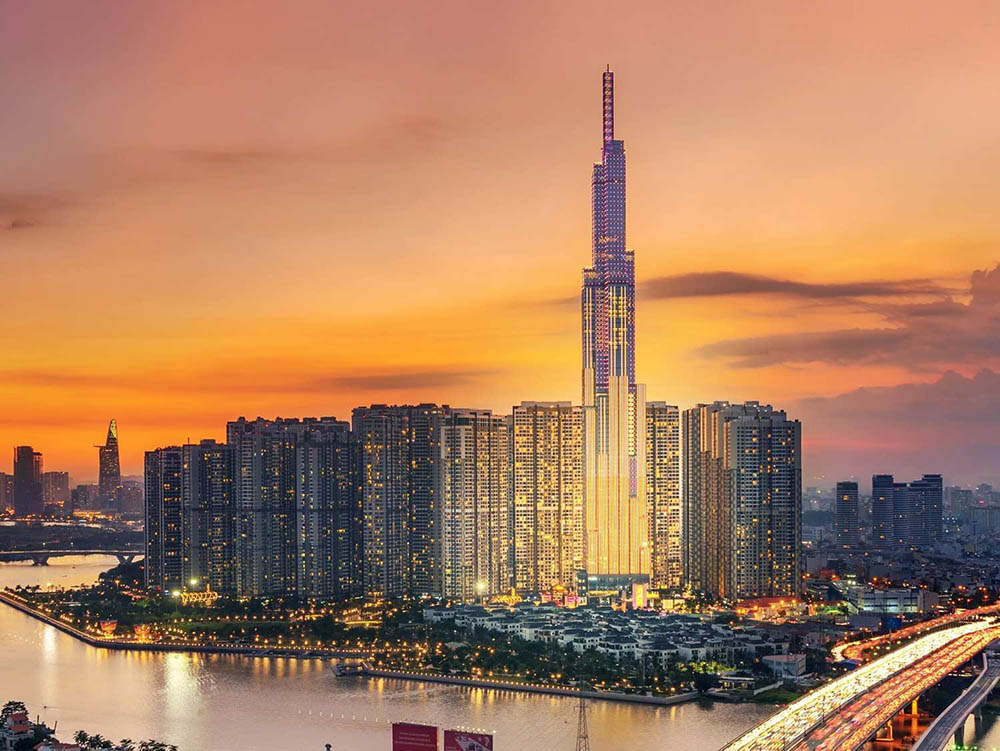
Ho Chi Minh City – Modern Energy Meets Tradition
If you prefer a more peaceful and historical Tet experience, Hue offers serenity and tradition in perfect harmony. As Vietnam’s former imperial capital, Hue celebrates Tet with royal grace. At the Imperial Citadel, visitors can witness royal court music, traditional dances, and ceremonial offerings reminiscent of Vietnam’s Nguyen Dynasty heritage.
In the early morning, locals visit Thien Mu Pagoda to light incense and pray for blessings. The Perfume River flows quietly beside the city, adorned with colorful boats and flower offerings. Hue’s slower pace and spiritual atmosphere make it an ideal destination for travelers seeking reflection and authenticity during Tet.
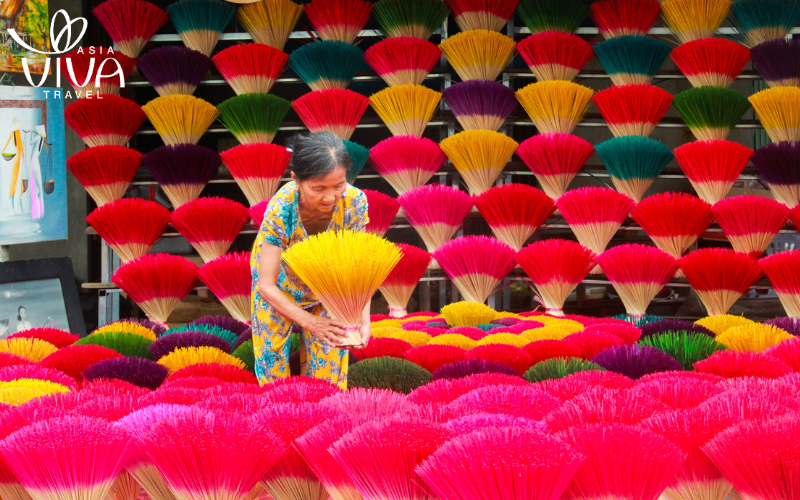
Hue – Imperial Calm and Heritage
Traveling to Vietnam during Tet Holiday is a deep cultural journey into the heart of Vietnamese life. Experiencing Tet allows you to truly understand the Vietnamese spirit of togetherness, gratitude, and renewal. Whether you join locals in preparing traditional dishes, watch dazzling fireworks over the rivers, or simply share a smile and a “Chúc Mừng Năm Mới” (Happy New Year), you’ll find yourself immersed in an atmosphere unlike any other.